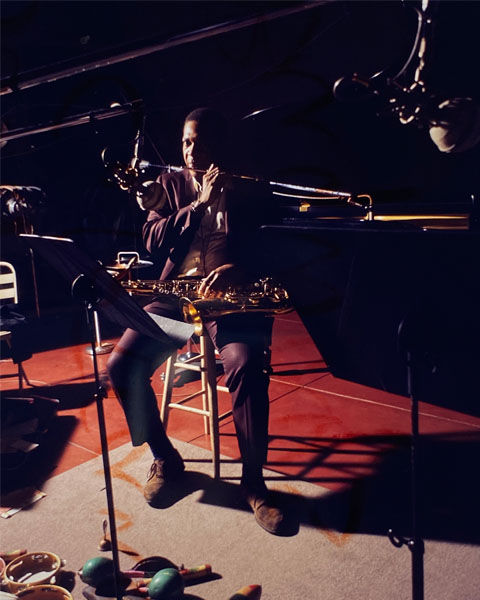
John Coltrane
(1926 – 1967)
Born September 23, 1926 in Hamlet North Carolina. Died July 17, 1967 at Huntington Hospital in Long Island NY. Coltrane grew up in High Point NC, moving to Philadelphia PA in June 1943.. Coltrane worked a variety of jobs through the late forties until (still an alto saxophonist) he joined Dizzy Gillespie’s big band in 1949. He stayed with Gillespie through the band’s breakup in May 1950 and (now on tenor saxophone) worked with Gillespie’s small group until April 1951, when he returned to Philadelphia to go to school.
Although there are recordings of Coltrane from as early as 1946, his real career spans the twelve years between 1955 and 1967, during which time he reshaped modern jazz and influenced generations of other musicians. Coltrane was freelancing in Philadelphia in the summer of 1955 when he received a call from trumpeter Miles Davis. Davis, whose success during the late forties had been followed by several years of decline, was again active, and was about to form a quintet. Coltrane was with this first edition of the Davis group from October 1955 through April 1957 (with a few absences), a period which saw influential recordings from Davis and the first signs of Coltrane’s ability. This classic First Quintet, best represented by two marathon recording sessions for Prestige in 1956, disbanded in mid-April.
During the latter part of 1957 Coltrane worked with Thelonious Monk at New York’s Five Spot, a legendary gig. He rejoined Miles in January 1958, staying until April 1960, during which time he participated in such seminal Davis sessions as Milestones and Kind Of Blue, and recorded his own influential sessions (notably Giant Steps).
Coltrane’s first working quartet took the stage in April 1960; pianist McCoy Tyner joined the band in mid 1960, and Elvin Jones came on board in the fall, in time for marathon sessions for Atlantic which produced Coltrane’s “hit” recording My Favorite Things. By early 1961 Coltrane had signed with the new Impulse label; his first project was a seminal orchestral recording, the Arrica/Brass sessions. Coltrane’s quartet (with Tyner, Jones and bassist Reggie Workman) was joined by multi-instrumentalist Eric Dolphy for a variety of recordings and appearances, and Dolphy joined the band permanently in September, in a group that created considerable controversy. The sound of that band is amply documented in the four nights recorded at the Village Vanguard in New York City in November 1961 (available in its entirety in a box set released in 1997). Dolphy left the group in April 1962, and for a variety of reasons Coltrane’s output during 1962 was more conservative. The year however is marked by several significant recordings (a Ballads album and a joint session with Duke Ellington). The Crescent session from mid-1964 is notable, but the peak of Coltrane’s output arguably is the prodigious amount of music recorded between December 1964 (the classic suite A Love Supreme) and November of 1965 (Meditations), including a variety of exceptional small group sessions and the “new music summit” Ascension.
By January 1966 the classic John Coltrane Quartet was no more, the internal tension of Coltrane’s quest for new directions having brought Tyner and Jones to depart. The last group, with Coltrane’s wife Alice on piano and Rashied Ali on drums (plus bassist Jimmy Garrison) is well represented by recordings of concerts in Japan and a variety of small group sessions from early 1967.
Coltrane died of liver cancer at the age of 40 on July 17, 1967, at Huntington Hospital on Long Island. His funeral was held four days later at St. Peter’s Lutheran Church in New York City. The service was started by the Albert Ayler Quartet and finished by the Ornette Coleman Quartet.[76] Coltrane is buried at Pinelawn Cemetery in Farmingdale, New York.
After Coltrane’s death, a congregation called the Yardbird Temple in San Francisco began worshiping him as God incarnate. The group was named after Charlie “Yardbird” Parker, whom they equated to John the Baptist. The congregation became affiliated with the African Orthodox Church; this involved changing Coltrane’s status from a god to a saint. The resultant St. John Coltrane African Orthodox Church, San Francisco, is the only African Orthodox church that incorporates Coltrane’s music and his lyrics as prayers in its liturgy.
It could be argued that Chuck Stewarts photographs of Coltrane are the most significant and iconic. We are privileged to be able to share some of them here.
Lorem ipsum dolor sit amet, consectetur adipiscing elit. Maecenas rutrum iaculis accumsan. Fusce tincidunt lectus in justo lobortis congue. Nunc viverra fermentum pellentesque.
In vitae lacus mi. Lorem ipsum dolor sit amet, consectetur adipiscing elit. Pellentesque gravida dictum sagittis. Praesent mollis, sem eu tincidunt commodo, sapien erat pulvinar odio, in ultricies nunc purus quis sem. Integer at hendrerit purus. Vivamus facilisis lectus sed iaculis tempor. Nullam pellentesque ligula nec placerat semper.








